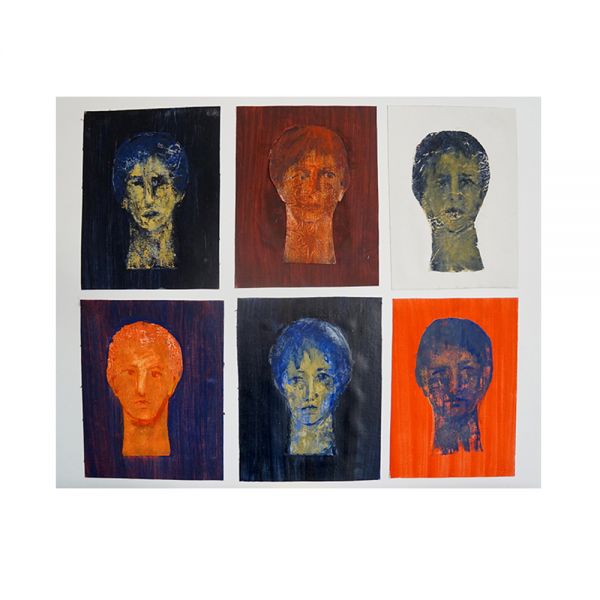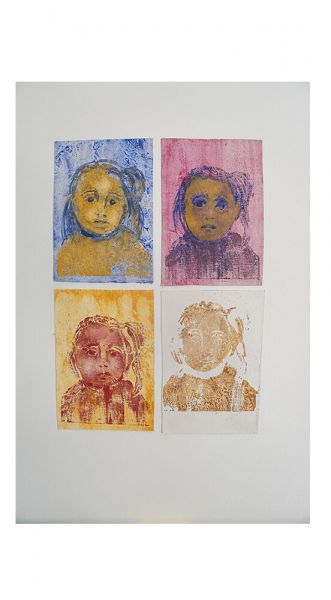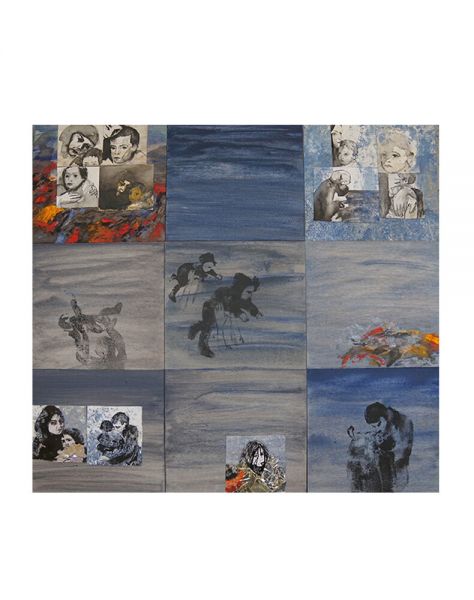

























GENEALOGY
1. One unit of miniature drawings-study of the face.
Reason: portraits of Greco in the “The Burial of the Count of Orgaz”. When you observe the expressions of faces in the forenamed work, you recognise all possible existential stances of people vis-à-vis death: despite the enormous changes mankind has been subjected to through time, the underlying core of its existence is recognizable. If you remove the clothing, which is typical of that era, both Fayum mummy portraits and the portraits of Rembrandt lead to the same conclusion.
Their look reflects something topical.
I attempted to copy these portraits as simply as possible. I drew persons of my social milieu live and myself based on photos. By offering many drawings together in small sections, what I am trying to do is make the spectator’s eye meet that of the portrayed persons disregarding the time separating them.
2. Faces – Monotypes
Due to my obsession with simplicity in my expressive means, colour in the 2nd section of faces-monotypes adds emotional intensity while detecting an archetypal touch, thus avoiding realism.
3. Faces of Refugees
The same approach vis-à-vis the face includes faces of refugees, mainly children, drawing material from topical photos, which actually put our meaning of life and faith in life itself to the test today.
In an era flooded by pictures, loose commitments and gloomy everyday life, meeting the eye of the other person and the creative act of man, in which the body also participates – which in my case is painting – may give us hope that the end of humanity is not approaching.
March 2017
Mato Ioannidou
Awe is the word I would use, if I had to put my impression in a nutshell, as I encounter these faces and their compositions. As I am not religious I have to clarify that this is about human awe: a dive into humanity through their eyes or maybe OUR eyes. It is not therefore accidental that Mato Ioannidou makes a reference to Greco: the artist par excellence who humanized the divine.
Human awe means awe for all of us, us as a genealogy, us as species, us as an infinite series, us as mirrors of ourselves. The refugees depicted not as unashamedly isolated, not as objects of artistic exploitation, but precisely entangled with us. The refugees are amongst us, as we all could have been or become refugees. This exhibition is perhaps for me the first acceptable artistic engagement with the refugees’ crisis. The refugees as part of the multitude. It is in this multitude after all that past and present co-exist, the faces of the refugees and of the non-refugees, and it is only the challenge of such a conjunction that moves forward the act of seeing and the act of thinking.
Humans are of the past and of the present, they are men and women, refugees and non-refugees, children and adults, they are beings with a gaze. It is because of the gaze that painting exists. It is because of the eyes and for the eyes. This homage to the eyes and to the gaze is read as a bet, a challenge, a resilience test. We know that many people cannot look each other in the eye. Such a communication bridge demands an internal continuity, an inside folding into the outside. If there is a break in this transfer, the gaze hangs as a rope cut. The artist agonizes for those who bear the weight of the gaze throughout the centuries.
These paintings for us, the non-believers, are equivalent to a confession of faith.
Maria Topali

